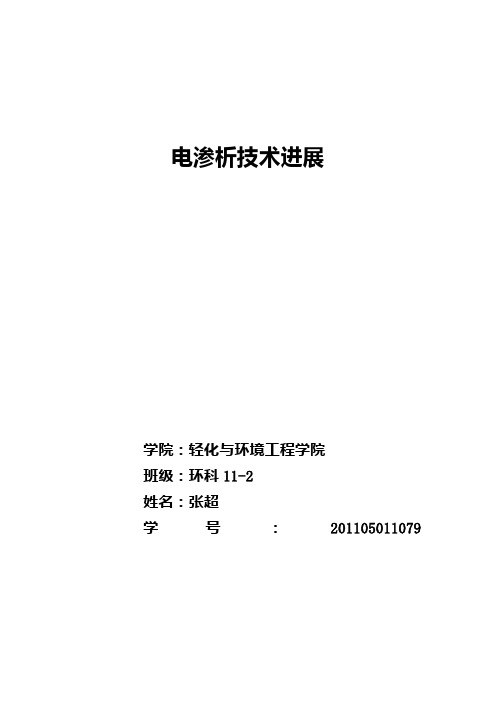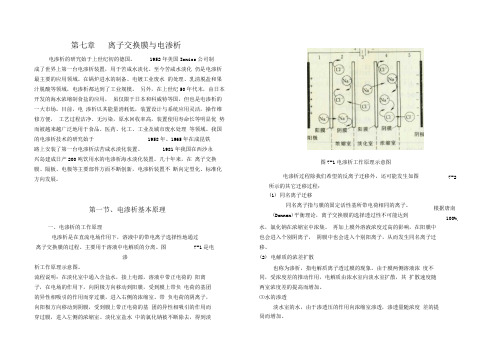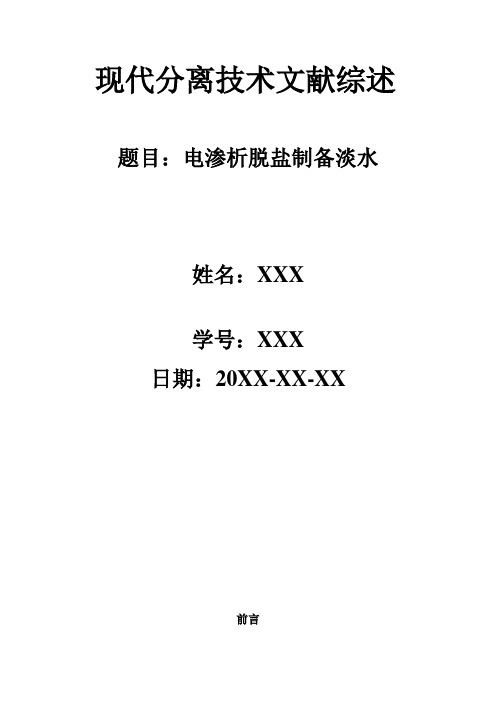电渗析文献综述
- 格式:doc
- 大小:34.00 KB
- 文档页数:7

电渗析技术:节水与环保并重的绿色科技在当今社会,水资源短缺和环境污染已成为全球性的挑战。
寻找一种既能有效节水又能减少环境负担的技术,成为了科学研究和技术创新的重要方向。
电渗析技术,作为一种集高效、节能、环保于一体的绿色科技,正逐步成为解决水资源和环保问题的关键力量。
一、电渗析技术的节水奥秘电渗析技术通过施加直流电场,利用离子交换膜的选择透过性,实现了对溶液中离子的精确分离和纯化。
这一过程中,水分子本身并未被消耗,而是被重新分配到了不同的隔室中,从而实现了水资源的最大化利用。
相比传统的蒸发浓缩方法,电渗析技术能够显著降低能量消耗,减少水资源浪费。
例如,在海水淡化过程中,电渗析技术能够将能量消耗降低80%以上,同时产生大量高质量的淡水,极大地缓解了沿海地区的用水压力。
二、环保优势的显著体现电渗析技术的另一大优势在于其环保性。
在处理水资源的过程中,该技术无需添加任何化学试剂,仅通过电场作用即可实现离子的分离和纯化。
这避免了传统处理方法中可能产生的副产物和二次污染问题,减轻了对环境的负担。
此外,电渗析技术还能够有效去除水中的重金属离子、有机物等有害物质,提高水质标准,为环境保护和生态安全贡献力量。
三、广泛应用领域的绿色实践电渗析技术的节水与环保优势,使其在众多领域得到了广泛应用。
在水处理方面,电渗析技术不仅用于海水淡化和苦咸水脱盐,还广泛应用于废水处理和饮用水净化等领域。
在化工和制药领域,电渗析技术则用于溶液分离、纯化等方面,提高了产品的纯度和质量。
此外,在食品、轻工、冶金等行业中,电渗析技术也发挥着重要作用,推动了相关产业的绿色发展和转型升级。
四、未来展望与技术创新随着科技的不断进步和应用领域的不断拓展,电渗析技术将迎来更加广阔的发展前景。
未来,我们可以期待以下几个方面的发展和创新:一是膜材料的不断改良和优化,提高电渗析膜的选择透过性和稳定性;二是电渗析设备的智能化和自动化水平提升,实现更精确的控制和更高效的运行;三是与其他水处理技术的结合应用,如与反渗透、超滤等技术相结合,形成更加完善的水处理系统;四是电渗析技术在更多领域的应用探索,如新能源领域、农业灌溉等,为可持续发展提供更多可能。

海水淡化电渗析海水淡化电渗析(Electrodialysis Desalination)引言:随着全球人口的持续增长和气候变化的加剧,淡水资源日益紧缺。
相较于淡水,海水资源丰富且广泛分布,然而海水中的高盐度使其无法直接作为饮用水或农业灌溉水源。
因此,海水淡化技术变得越来越关键。
本文将重点介绍一种常用的海水淡化技术——电渗析(Electrodialysis Desalination)。
第一部分:电渗析技术原理及过程电渗析是一种利用电解质溶液中的离子在电场中迁移的现象,实现溶液中离子分离和除盐的方法。
电渗析过程通过交替排列的正负离子交换膜和浓水腔、稀水腔,以及外加电场的作用,实现了海水中盐分的去除。
第二部分:电渗析技术的优点相较于其他海水淡化技术,电渗析具有以下几个优势:1. 较低的能耗:电渗析所需的能量主要用于外加电场,相比于蒸馏等其他技术,其能耗较低。
2. 资源利用:在淡化过程中,电渗析技术可以同时回收海水中的其他有价值的化学品和溶质,实现了资源的综合利用。
3. 操作灵活性:电渗析设备可以根据需要进行组合和扩展,以适应不同规模和需求的淡化项目。
4. 环境友好:与传统的热法淡化技术相比,电渗析过程不需要产生高温蒸汽,因此减少了对环境的不良影响。
第三部分:应用案例电渗析技术已经在世界各地有广泛的应用,并取得了可喜的效果。
以下是一些典型的应用案例:1. 小型海水淡化设备:电渗析技术可以被应用于小规模的海水淡化设备,用于满足农村地区的饮用水需求。
2. 偏远地区供水:一些偏远地区的供水问题可以通过电渗析技术得到解决,从而改善当地居民的生活条件。
3. 大型海水淡化工程:在一些岛屿国家和沙漠地区,电渗析技术被应用于大规模的海水淡化工程,为当地的工业用水和居民生活提供可持续的水资源。
第四部分:对海水淡化电渗析技术的观点和理解海水淡化电渗析技术作为一种可持续的解决方案,有助于应对全球淡水资源短缺的挑战。
其低能耗、资源回收和环境友好等优点使之成为海水淡化领域的重要技术之一。

电渗析技术进展学院:轻化与环境工程学院班级:环科11-2姓名:张超学号:201105011079Progress electrodialysisAbstract: electrodialysis membrane separation technology are widely used in food, chemical, waste water treatment and other industries of the separation and purification of the production process, high efficiency, clean and economical energy saving. This paper describes the types of electrodialysis technology, focuses on the principle of electrodialysis technology, introduces electrodialysis technology in the food industry as well as applied research in wastewater treatment, and the prospects of its development prospects. Keywords: electrodialysis; film; ApplicationElectrodialysis is under the effect of external electric field, the use of ion-exchange selective membrane permeability, so that ion migration from one part of water to another part of the physical and chemical processes in water. Electrodialysis, is the use of multi-compartment electrodialysis desalination process to achieve the purpose. Main components electrodialysis membrane, electrodes, clamps or the like by a partition, ion-exchange composition. Ion exchange membranes for ions with different charge through sexual selection. Yang membrane allows only cations, anions stop by, overcast membrane only allows anions, cations stop by. Under the influence of an external DC electric field, ions in water as directed migration.Because electrodialysis is composed by multi-compartment, so light ions migrate to the chamber adjacent to concentrate cells, allowing saline water desalination. Inthe food and pharmaceutical industry, electrodialysis can be used to remove organic ions from the electrolyte solution, whey desalination, desalination sugars and amino acids are more refined application was successful [1]. As a new electrodialysis membrane separation technology, in natural water desalination, seawater concentrated salt, waste water treatment, etc. [2] plays an important role, has become a more sophisticated water treatment methods.1. Type electrodialysis technology1.1 inverted pole electrodialysis (EDR)Inverted pole electrodialysis ED principle is based, at regular intervals (typically 15 ~20 min), the positive and negative electrode polarity switching each other, dirt can automatically clean the ion-exchange membrane and the electrode formed on the surface, in order to ensure the efficiency of the ion exchange membrane the long-term stability and the quality and quantity of fresh water.1.2 Liquid electrodialysis (EDLM)Electrodialysis film with the same function instead of solid liquid membrane ion exchange membrane [3], the experimental model is to use a semi-permeable cellophane bag made of thin liquid film solution like partitions, and then into electrodialyser run. Liquid extraction agent for use electrodialysis membrane film may find efficient separation method for enrichment and extraction of precious metals, heavy metals, rare metals, etc., because the film looking for some form of special selective ion extractionefficiency and improve electrodialysis related. Improve the separation efficiency of electrodialysis, combined direct and film it is promising.1.3 packed bed electrodialysis (EDI)Packed bed electrodialysis (EDI) is a new treatment method that combines electrodialysis and ion exchange, its biggest feature is the use of water dissociation of H + and OH- generated automatically filled in renewable freshwater compartment electrodialysis mixed bed ion exchange resin, in order to achieve a sustained deep desalination. Which focused on the advantages of electrodialysis and ion exchange method, to improve the limiting current density and current efficiency.1.4 bipolar membrane electrodialysis (EDMB)Bipolar ion-exchange membrane is a novel composite membrane, it is generally laminated together by a cation exchange membrane, the water molecules through the membrane instantly decomposed into H + and OH-, may be used as a supply of H + and OH- in. Bipolar membrane electrodialysis prominent advantage is the process simple, high energy efficiency, less waste emissions.1.5 The Promise water electrodialysisPromise is a modified form of water electrodialysis electrodialysis tradition, its main feature is the removal of the traditional electrodialysis pole and electrode. E.g., electrode means in one or more layers close to the ion exchange membrane, which are electrically coupled to each other, so that bothcan prevent the metal ions into the ion-exchange membrane, while preventing the plate fouling and prolong the service life of the electrode . With the removal of the electrode compartments, stepless water discharge, greatly improving the utilization of raw water [4].2.The electro-osmosis technology in the food industry2.1 Application of inulin productionInulin is a polysaccharide having health functions, system owners by β- (2, 1) fructan molecules glycosidic linkage, also linked at the end of a glucose residue. Its degree of polymerization of from 2-60, spanning classic definition of oligosaccharides, so it was put in a range of inulin oligosaccharides called oligofructose inulin. Inulin is widely distributed in the middle of a variety of plants, of which the largest amount of chicory inulin, Jerusalem artichoke and dahlia containing (about 20% dry basis), with the value of the commercial production of inulin.Yang Lian and other crude inulin using electrodialysis in the purification process applied research carried out in the course of electrodialysis, pH, chrysanthemum sugar solution at a constant decline for some time, the time constant of the operating voltage and electrodialysis negative related decline in the operating voltage of the positive correlation between pH. Ju sugar solution and an ash content of crude protein can be removed by electrodialysis, the greater the operating voltage, the faster the rate of decline of charged impurities, in an initial stage of electrodialysis these charged impurities removed faster.Free amino acids as a result of smallermolecules more easily removed than short peptides. Inulin at 10V operating voltage conditions, hydrolysis of inulin no obvious single, double sugar content increased only slightly. Ju sugar solution in electrodialysis process continuously diluted, but inulin molecules can not pass through the ion exchange membrane electrodialysis so purified inulin have higher recovery. At a voltage of 10V, the use of flow 10L / h, and after electrodialysis 1h, crudeinulin 70% ash and 47% crude protein is removed, the total loss ofthe original sugar only 4%.In short, can be effectively used as a crude inulin electrodialysis desalination and deproteinized and economic means, with the follow-up actions, such as ultrafiltration good convergence, can greatly reduce the pressure downstream purification operation is technically feasible [5].2.2 Application in the production of bamboo shootsAlong with the traditional bamboo processing to produce a lot of waste Bamboo Shoots, for example, about 30% of edible part, while about 30% bamboo shell, shoot first 40%, in addition, will produce large amounts of waste processed bamboo shoots boiled water[6] .Shoots dope (shoots boiled water) is rich in sterols, polysaccharides, amino acids, vitamins, flavonoids, Dai soap and salt and other natural active ingredients, the presence of these salts on the one hand is not conducive to the classification and purification of amino acids and other ingredients from the stock solution, the impact the nutritional value of bamboo shoots dope [7], on the other hand, if treated on direct emissions will cause soil compaction, plant burns, pollute the water. In addition, bambooextract also contains cadmium, lead (<0. 5mg / kg), arsenic (<0. 3mg / L) and other heavy metal ions, directly processed into products in the food field, the body will have a negative impact [8], through desalination can effectively remove heavy metal ions, so as to achieve the standards prescribed by the state.Therefore, bamboo shoots dope desalination research has social and economic benefits, to achieve deep conversion and utilization of bamboo processing waste, and the development of high value-added products, improve enterprise management level economic and industry, upgrading of traditional industries. Michael, etc[9]. On the basis of experiments to explore the feasibility and process optimization shoots dope desalination by ion exchange membrane electrodialysis.After 90m in desalination, shoots dope ash fell 49.10%, the main element contents: potassium decreased 53.76%, 75.27% decrease sodium, calcium decreased 69.80%, 57.86% decrease magnesium, iron decline 66.67%, 76.98% decline in copper, cadmium fell 42.51%[10], while the number of heavy metal ion content is generally low, are within the scope of the national standards, such as mercury and arsenic were not detected, so the electrodialysis of bamboo shoots dope desalination better[11]. Amino acid content before and after the desalting shoots dope flat:Before the amino acid content of 8.22 percent desalination (dry basis), the amino acid content of desalinated 8.37% (dry basis), and according to the amino acid test report to know: before and after shoots dope desalination and various types of amino acids approximately the same percentage of the class, so the electrodialysisdesalination technology shoots dope on which functional components - the smaller the impact of amino acids [12].2.3 Application in the production of soy sauceSoy sauce is one of people's daily lives the most popular condiment, usually soy sauce salt content of 16% to 18%,[13] which is due to soy sauce koji is made in an open state, in order to avoid microbial contamination, need high lower salt concentrations, and the unique flavor of soy sauce only at this salt concentration can lead. Modern medicine has shown that high sodium diet easily lead to high blood pressure,[14] kidney disease and other diseases, because of the high salt content of ordinary soy sauce, to meet the demand for low-sodium diet can be an ordinary soy sauce in a low salt removal salt soy sauce [15]. Soy sauce flavor virtually unchanged, soy sauce proved electrodialysis desalination is feasible separation method [16].3.Electro-osmosis technology in wastewater treatment3.1 electro-osmosis technology research ammonium nitrate condensatewastewater treatment[17]Ammonium nitrate is the basic chemical raw materials and agricultural chemical fertilizer, widely used in agriculture, defense, chemical, pharmaceutical, textile, light industry and other fields. Due to historical reasons, China's traditional ammonium nitrate production facilities are mostly obsolete technology and equipment,[18] backward technology, low level of environmental protection, a large amount of nitrogen-containing industrialwaste in the production process. In particular, since the production process of ammonium nitrate is determined by the dilute nitric acid into the water in the neutralization, evaporation and crystallization process in the form of secondary steam discharge, process condensate formed contains ammonia and ammonium nitrate, ammonium nitrate production has become a major water source.Limited use of 24 units Chuanhuagufen electrodialysis unit has a special dedicated film electrodialysis device consisting of a maximum amount of condensate wastewater treatment for 36 t / h,[19] ammonium nitrate condensing water circulating through electrodialysis device concentrate, after desalination treatment, concentrated ammonium nitrate content in water volume percentage is 20%,[20] more than 96% recovery rate, qualified freshwater discharge water mass fraction of ammonia content! 40mg / L.Not only to achieve the reduction of nitrate wastewater emissions, pollution abatement purposes, but also improve the comprehensive utilization of resources, reduce production costs, and achieved significant environmental and economic benefits [21].3.2 Research ammonia wastewater treatment electro-osmosis technologyWith the rapid development of China's economy[22], emissions of various pollutants increased dramatically, especially on the environment caused serious water pollution, data show, ammonia nitrogen[23], phosphorus and other pollutants in surface water main. Excessive emissions of ammonia wastewater is one of the main reasons eutrophication. Deaminase methodscurrently used in industry mainly biological nitrogen removal method, air stripping, breakpoint chlorination, ion exchange method [24]. Biological nitrogen removal method is suitable for the treatment of low concentration of ammonia nitrogen waste water containing organic matter, the law technically reliable, good effect, mainly used in chemical wastewater containing ammonia and sewage treatment[25]. Breakpoint chlorination and ion exchange method is suitable for wastewater treatment free of organics of low concentrations of ammonia[26].For high concentrations of inorganic ammonia wastewater, such as nitrogen fertilizer plant wastewater, many industrial applications currently using air stripping, but deaminase rate was 70%, can not meet the national emission standards, and large investments, secondary pollution [27]. Tang Yan, such as the use of electrodialysis ammonia wastewater treatment, process conditions were optimized to obtain process parameters under laboratory conditions[28]. Electrodialysis voltage of 55V, the water flow is 24L / h, ammonia wastewater influent conductivity of 2920 s / cm, ammonia concentration was 534. 59mg / L. Concentrated water and fresh water chambers each 19% and 81%, the concentration of water and fresh water conductivity was 14000 s / cm and 11. 8 s / cm, ammonia content was 2700mg / L and 13mg / L[29]. Ammonia wastewater processed after the electrodialysis device to meet emission standards, to meet the reuse requirements [30].4.Prospects:With the deepening of the scientific concept of development,sustainability needs of China's economic development, energy conservation, clean industrial development, among other factors, membrane separation technologies are penetrating into all areas of industry and research, development and scale applications in the field has also been accelerated.,, Especially in the food industry, biological products, pharmaceuticals, chemical separation and other areas, has made tremendous progress. With the continuous development of science and technology, continuous improvement of membrane technology, continue to lower the cost of film, the new electrodialysis equipment manufacturing level will be greatly improved, the manufacturing cost of the equipment will be greatly reduced, and it will meet more modern industry high separation requirements, electrodialysis technology will be rapid development. In short, electrodialysis technology for industrial wastewater treatment and separation technology, will accelerate the modernization of industrial application prospect is very considerable. References:[1]张维润. 电渗析工程学[M ]. 北京: 科学出版社, 1995: 1-3, 117-128.[2]汪建芳,汤建华.电渗析浓缩回收硫酸钠溶液的实验研究[J]水处理技术,2002,28(5):288-289.[3]华河林,等. 电渗析技术的新进展[J ] . 环境污染治理技术与设备,2001 ,2 (3) :46.[4]华河林,等. 电渗析技术的新进展[J ] . 环境污染治理技术与设备,2001 ,2 (3) :44.[5]杨炼,江波,冯骉等.电渗析在粗菊糖纯化过程中的应用[ J] .食品科学, 2006, 27( 7):119-123.[6]马玉梅. 低盐酱油在日本的研究利用状况[ J]. 中国调味品, 1997( 10): 11-12.[7]赵霖, 鲍善芬. 21世纪中国食品安全问题[ J]. 中国食物与营养, 2001( 2): 5-7.[8]黄伟, 刘东红. 竹笋原液电渗析脱盐工艺的研究[ J].食品与发酵工业, 2007, 33( 3): 72-74.[9]马玉梅. 低盐酱油在日本的研究利用状况[ J]. 中国调味品, 1997( 10): 11-121. [ 10]刘贤杰, 陈福明. 电渗析技术在酱油脱盐中的应用[ J] . 中国调味品, 2004( 4): 17-21.[11]汪家铭. 利用电渗析技术处理硝酸铵冷凝废水[ J].泸天化科技, 2009( 2): 184-186+ 193.[12]许国强, 曾光明. 氨氮废水处理技术现状与发展[ J].湖南有色金属, 2002, 26( 2) : 37-40.[13]钟理, 谭春伟. 高浓度氨氮废水处理技术[ J]. 北京工商大学学报, 2004, 22( 2) : 5-8.[14]唐艳, 凌云. 氨氮废水的电渗析处理研究[ J]. 中国资源综合利用, 2008, 126( 3): 27-29.[15 ] Xu Tongwen , Yang Weihua. [ J ] . Chemical Engineering and Processing , 2002 , 41 : 519~524[16 ] Pinacci P , Radaelli M. [J ] . Desalination , 2002 , 148 : 177~179[17] Senad Novalic , James Okwor , et al . [J ] . Desalination , 1996 , 105 :277~282[18] Francisco Alvarez , Ricardo Alvarez , Jose Coca , et al . [J ] . Journal of Membrane Science , 1997 , 123 : 61~69[19] Senad Novalic , Teeraporn Kongbangkerd , Klaus D , Kulbe , et al .[J ] . Journal of Membrane Science , 2000 , 166 : 99~104[20] Hong Li , Roberta Mustacchi , Christopher , et al . [J ] . Tetrahedron ,2004 , 60 : 655~661[21] Rathin Datta , Shih Perng Tsai , Patrick Bonsignore , et al . [ J ] .PEMS Microbiology Reviews , 1995 , 16 : 221~231[22 ] Yu Lixin , Guo Qingfeng , Hao Jihua , et al . [J ] . Desalination , 2000 ,129 : 283~288[23] Liu K J , Chlanda F P , Nagsubramanian K. A [ J ] . Journal of Membrane Science , 1978 ,3 : 57~70[24] Liu KJ , Nagsubramanian K, Chlanda F P. [J ] . Journal of Membrane Science , 1978 , 3 :71~83[25] 余立新,孟昭辉.林爱光等. [ J ] .环境科学, 1996 , 17(6 ) : 40~42[26] 保积庆,张启修. [J ] .膜科学与技术, 2003 , 23 (2) : 32~36[27] 李福勤,杨云龙,李清雪等. [J ] .中国给水排水, 2001 , 17(10) : 74~76[28] Chao Y C , Chlanda F P , Mani K N. [ J ] . Journal of MembraneScience , 1991 , 61 : 239~252[29] Cauwenberg V , Peels J , Resveut S , et al . [ J ] . SeparationPurification Technology , 2001 (22 23) : 115~121[30] Bazinet L , Lamarche F , Ippersiel D. [J ] . Trend in Food Science & Technology , 1998 , 9 : 107~113。

电渗析海水淡化除硼的研究电渗析海水淡化除硼的研究摘要:海水淡化作为解决干旱地区用水问题的重要手段之一,引起了广泛的关注。
然而,海水中存在的硼元素对人体健康带来了潜在的危害。
本文通过电渗析技术,以去除海水中的硼元素为目标,对海水淡化技术进行了深入研究。
实验结果表明,电渗析技术能够有效去除海水中的硼元素,为海水淡化提供了一种可行的解决方案。
1. 引言随着人口的不断增长和气候变化的加剧,水资源短缺问题日益突出。
海水淡化技术作为一种解决方法,因其可利用丰富的海水资源而备受关注。
然而,海水中存在的硼元素对人体健康构成潜在的威胁,因此去除海水中的硼元素成为了海水淡化的重要环节。
2. 研究方法本研究采用电渗析技术对海水进行处理,以去除其中的硼元素。
电渗析技术是一种以电阻装置为核心的膜分离技术,通过外加电场作用使离子在膜上移动,实现溶液中离子的分离和浓缩。
通过设计合适的电场参数以及膜材料的选择,可以实现对硼元素的有效去除。
3. 结果与讨论实验结果表明,采用电渗析技术可以显著降低海水中的硼含量。
在设定的电场强度和温度条件下,硼元素通过膜去除率达到了90%以上,远高于传统的海水淡化方法。
此外,实验还探究了影响电渗析效果的因素,包括膜材料的选择、电场强度的调节等。
结果表明,采用聚合物膜材料并增加电场强度可以进一步提高电渗析效果。
同时,本研究对电渗析过程中的能量消耗进行了估算。
结果发现,与传统的蒸馏方法相比,电渗析技术在能耗上具有明显的优势。
这些结果表明,电渗析技术具有良好的应用前景,可作为一种高效、经济的海水淡化除硼方法。
4. 结论本研究通过电渗析技术对海水淡化中的硼元素进行了深入研究。
实验结果表明,电渗析技术可以有效去除海水中的硼元素,为广大地区缺水问题提供了一种可行的解决方案。
此外,电渗析技术具有能耗低、效率高等优点,对于推动海水淡化技术的发展具有积极的意义。
然而,还需要进一步研究电渗析过程中各参数的优化以及技术的实际应用情况,以提高其工程化应用的可行性。

一、电渗析的工作原理电渗析是在直流电场作用下,溶液中的带电离子选择性地通过 离子交换膜的过程。
主要用于溶液中电解质的分离。
图7-1是电渗析工作原理示意图。
流程说明:在淡化室中通入含盐水,接上电源,溶液中带正电荷的 阳离子,在电场的作用下,向阴极方向移动到阳膜,受到膜上带负 电荷的基团的异性相吸引的作用而穿过膜,进入右侧的浓缩室。
带 负电荷的阴离子,向阳极方向移动到阴膜,受到膜上带正电荷的基 团的异性相吸引的作用而穿过膜,进入左侧的浓缩室。
淡化室盐水 中的氯化钠被不断除去,得到淡水,氯化钠在浓缩室中浓集。
再加上膜外溶液浓度过高的影响,在阳膜中也会进入个别阴离子, 阴膜中也会进入个别阳离子,从而发生同名离子迁移。
(2) 电解质的浓差扩散也称为渗析,指电解质离子透过膜的现象。
由于膜两侧溶液浓 度不同,受浓度差的推动作用,电解质由浓水室向淡水室扩散,其 扩散速度随两室浓度差的提高而增加。
⑶水的渗透淡水室的水,由于渗透压的作用向浓缩室渗透,渗透量随浓度 差的提咼而增加。
第七章 离子交换膜与电渗析电渗析的研究始于上世纪初的德国。
1952年美国Ionics 公司制 成了世界上第一台电渗析装置,用于苦咸水淡化。
至今苦咸水淡化 仍是电渗析最主要的应用领域。
在锅炉进水的制备、电镀工业废水 的处理、乳清脱盐和果汁脱酸等领域,电渗析都达到了工业规模。
另外,在上世纪50年代末,由日本开发的海水浓缩制食盐的应用, 虽仅限于日本和科威特等国,但也是电渗析的一大市场。
目前,电 渗析以其能量消耗低,装置设计与系统应用灵活,操作维修方便, 工艺过程洁净、无污染,原水回收率高,装置使用寿命长等明显优 势而被越来越广泛地用于食品、医药、化工、工业及城市废水处理 等领域。
我国的电渗析技术的研究始于 1958年。
1965年在成昆铁 路上安装了第一台电渗析法苦咸水淡化装置。
1981年我国在西沙永 兴岛建成日产200吨饮用水的电渗析海水淡化装置。

现代分离技术文献综述题目:电渗析脱盐制备淡水姓名:XXX学号:XXX日期:20XX-XX-XX前言自1954年首台电渗析样机在美国问世以来,电渗析在世界各地得到广泛的应用。
在1955年建立了中试厂并且运转成功随之在1957年有了工业规模的电渗析脱盐厂。
目前,电渗析的主要应用仍是处理咸水提供应用水。
在美国已广泛用于乳品工业的奶酪脱盐柑桔汁浓缩并正逐步用于工业废水处理;日本主要用于海水浓缩制取食盐,电渗析的实际应用潜力很大如经离子交换膜电解从己二酸制癸二酸丙烯睛制己二腊等都有引人注意的前景。
我国1958年开始电渗析的理论研究工作,到70年代开始了工业化生产,至今已具备相当规模,主要用于海水淡化和纯水制备,为电渗析的广泛应用创造了有利条件。
主题一、电渗析的基本原理及依据(1)电渗析概念渗析过程的速度较慢,如果在膜两边施加一个直流电塌就加快了离子的迁移速度。
这种离子在电塌作用下通过膜进行的迁移过程,称为电渗析。
根据所用膜种类的不同电渗又可分为如下两类:1、非选择性膜电渗析非选择性膜电渗析,原来是溶胶的一种提纯方法。
已经有几十年的历史。
利用天然半透膜(如膀胧膜)或人工半透膜(如火棉胶膜羊皮纸等) 能透过离子而不能透过颗粒较大的胶体粒子的性质在外加直流电塌的作用下作为杂质的离子就从溶胶中穿过半透膜进入到水中被水流带走,从而使溶胶得到了纯化。
2、选择性膜电渗析为了使含盐水得以脱盐淡化,将非选择性伞透膜改为离子选择性透过膜。
如图1所示靠近阴极的阳离子交换膜只允许通过阳离子而排斥阴离子靠近阳极的阴离子交换膜,只允许通过阴离子而排斥阳离子。
阴膜和阳膜将容器分成三个隔室。
靠阴极的一个隔室称为阴极室靠阳极的一个隔室称为阳极室,这样就构成了一个最简单的双膜三室电渗析淡化器。
图1 使用离子交换膜电渗析脱盐示意图接上道流电源后在道流电爆作用下中间隔室中的阳离子不断穿过阳膜迁移到阴极室,而阴离子不断穿过阴膜迁移到阳极室,但是阳极室中的阳离子在向阴极迁移的过程中不能穿过阴膜,阴极室中的阴离子在往阳极迁移的过程中也不能穿过阳膜。
电渗析技术研究现状与进展
黄万抚;罗凯;李新冬
【期刊名称】《过滤与分离》
【年(卷),期】2003(013)004
【摘要】简述了电渗析技术的几种类型,并对电渗析技术在水处理、食品和化工方面应用的研究现状和发展前景进行了综述.
【总页数】5页(P20-23,31)
【作者】黄万抚;罗凯;李新冬
【作者单位】南方冶金学院,江西,赣州,341000;南方冶金学院,江西,赣州,341000;南方冶金学院,江西,赣州,341000
【正文语种】中文
【中图分类】TQ028.7+4
【相关文献】
1.联碱工业高浓度氨氮废水电渗析处理技术研究 [J], 田原;钟振宇;邹冬生;秦普丰;付广义
2.电渗析膜污染与清洗技术研究进展 [J], 杨晓伟;王丁;齐麟;高德堂;赖冰冰;张培;郭春禹
3.电渗析海水淡化技术研究进展 [J], 王浩歌;王小娟
4.基于文献计量学的电渗析技术研究现状与趋势分析 [J], 胡小阳;褚衍旭;王红萍
5.电渗析-超滤耦合技术研究进展 [J], 苏慧超;张田明;吴云奇;徐国荣
因版权原因,仅展示原文概要,查看原文内容请购买。
电渗析技术的原理及应用电渗析技术的原理及应用第一章引言电渗析技术是一种利用电场作用将溶液中的离子或分子分离的方法,广泛应用于水处理、环境监测、生物医学等领域。
本文将详细介绍电渗析技术的原理及其在不同领域中的应用。
第二章电渗析技术的原理2.1 电渗析基本原理电渗析技术是利用电场和渗析过程结合,实现离子或分子的分离和浓缩。
当在溶液中施加电场时,溶液中的离子或分子将受到电场力的作用向电极移动。
根据离子的电荷和迁移速度的差异,离子或分子将在电场中分离和迁移。
2.2 渗析膜的选择在电渗析过程中,渗析膜的选择是至关重要的。
渗析膜应具有良好的选择性和传质性能。
常用的渗析膜包括阳离子交换膜、阴离子交换膜和中性渗析膜。
不同的渗析膜用于不同的分离任务。
第三章电渗析技术的应用3.1 水处理领域电渗析技术在水处理领域中被广泛应用。
通过电渗析技术可以实现溶液的除盐、去除重金属离子、浓缩废水等目的。
电渗析技术具有处理效率高、操作简便等优点,因此在水处理中得到了越来越广泛的应用。
3.2 环境监测领域电渗析技术可用于环境样品的分析和监测。
例如,通过电渗析技术可以检测土壤中的污染物浓度、水体中的有害离子含量等。
该技术对样品的前处理要求低,不仅提高了分析的准确性和效率,还节省了时间和成本。
3.3 生物医学领域电渗析技术在生物医学领域中有着广泛的应用。
它可以用于生物体内药物的释放、蛋白质的富集和分离。
通过调节电场强度和渗析膜的性质,可以实现对不同药物或蛋白质的选择性分离和富集,有助于疾病的治疗和研究。
第四章电渗析技术的优势和挑战4.1 优势电渗析技术具有高效、无需添加化学试剂、不产生二次污染等优势。
它可以快速分离溶液中的离子或分子,且操作简便,适用于大规模处理。
4.2 挑战电渗析技术在应用过程中也面临一些挑战。
例如,渗析膜的选择和优化需要对渗析机制和膜材料进行深入研究;离子和分子的迁移速度受到离子浓度、电场强度等因素的影响,需要进行更精细的控制。
《化工前沿技术》结课论文关于“电渗析技术”综述学 院专 业年级班别学 号学生姓名指导教师2015年 6月 28日JINGCHU UNIVERSITY OF TECHNOLOGY目录目录 (2)关于“电渗析技术”综述 (3)摘要 (3)1 前言 (3)2 电渗析技术原理 (3)2.1 电渗透技术特点 (4)3 常见的电渗析技术 (4)3.1 填充床电渗析( EDI) (4)3.2 倒极电渗析( EDR) (5)3.3 高温电渗析 (5)3.4 无极水电渗析技术 (5)3.5 卷式电渗析 (5)3.6 液膜电渗析( EDLM) (6)3.7 双极性膜电渗析( EDMB) (6)3.8 离子隔膜电解 (6)4 电渗析技术实际应用 (7)4.1 工业废水处理 (7)4.2 食品和化学工业应用 (7)5 电渗析发展的限制 (8)6 结语 (8)参考文献 (9)关于“电渗析技术”综述摘要电渗析技术是膜分离技术之一, 由于具有高效、低能耗等特点已经被多个行业广泛使用。
本文阐述了几种新的电渗析技术, 包括无隔板电渗析、填充床电渗析、双极膜电渗析等, 并探讨和综述其研究现状和发展前景。
【关键字】电渗析技术应用前景1 前言电渗析利用半透膜的选择透过性来分离不同的溶质粒子(如离子)的方法称为渗析。
在电场作用下进行渗析时,溶液中的带电的溶质粒子(如离子)通过膜而迁移的现象称为电渗析。
利用电渗析进行提纯和分离物质的技术称为电渗析法,电渗析的研究始于德国, 1903 年, M- orse 和Pierce 把两根电极分别置于透析袋内部和外部的溶液中发现带电杂质能更迅速地从凝胶中除去;1924 年, Pauli 采用化工设计的原理, 改进了 Morse的试验装置, 力图减轻极化, 增加传质速率; 但直到1950 年 Jude首次试制成功了具有高选择性的离子交换膜后, 电渗析技术才进入实用阶段。
它是20世纪50年代发展起来的一种新技术,最初用于海水淡化,现在广泛用于化工、轻工、冶金、造纸、医药工业,尤以制备纯水和在环境保护中处理三废最受重视,例如用于酸碱回收、电镀废液处理以及从工业废水中回收有用物质等。
节水新篇章:电渗析技术的绿色贡献与效益在当今全球水资源日益紧张的背景下,探索高效、环保的水处理技术成为了人类共同的课题。
电渗析技术,作为一种先进的膜分离技术,正以其独特的优势和广泛的应用领域,在节水事业中书写着新的篇章,为地球的可持续发展贡献着绿色力量。
绿色贡献:守护水资源,促进生态平衡电渗析技术的绿色贡献首先体现在其对水资源的保护与节约上。
通过高效去除水中的盐分和杂质,电渗析技术能够将原本无法直接利用的海水、苦咸水等转化为可供人类生活和工业生产使用的淡水。
这一过程不仅缓解了水资源短缺地区的用水压力,还减少了对地下水、河流等自然水体的开采,从而保护了脆弱的生态环境。
此外,电渗析技术在废水处理中的应用也显著降低了废水排放对环境的污染,促进了生态平衡的恢复与维持。
效益显著:经济、社会与环境的多重回报电渗析技术不仅具有显著的绿色贡献,还带来了经济、社会与环境的多重效益。
从经济效益来看,电渗析技术在海水淡化、苦咸水脱盐等领域的应用,为沿海地区和干旱地区提供了稳定的水资源来源,降低了因缺水而导致的经济损失。
同时,通过回收废水中的有用物质,电渗析技术还实现了资源的再利用,提高了企业的经济效益。
从社会效益来看,电渗析技术的应用保障了人们的饮水安全,提高了生活质量,促进了社会的和谐稳定。
此外,该技术还推动了节水意识的普及和水资源的可持续利用,为社会的可持续发展奠定了坚实基础。
从环境效益来看,电渗析技术的环保无污染特点,减少了化学药剂的使用和废水排放对环境的污染,为地球的绿色未来贡献了力量。
展望未来:技术创新引领节水新潮流随着科技的不断进步和人们对节水意识的日益增强,电渗析技术将在节水领域发挥更加重要的作用。
未来,电渗析技术将不断进行创新和完善,提高处理效率、降低能耗和成本,以更好地满足人们对高质量水资源的需求。
同时,随着物联网、大数据等先进技术的融入,电渗析设备将实现更加智能化、自动化的运行和管理,提高设备的稳定性和可靠性。
电渗析文献综述
土木工程学院
给水排水工程
1,电渗析技术有哪些?
1.1什么是电渗析?渗析是属于一种自然发生的物理现象。
如将两种不同含盐量的水,用一张渗透膜隔开,就会发生含盐量大的水的电介质离子穿过膜向含盐量小的水中扩散,这个现象就是渗析。
这种渗析是由于含盐量浓度不同而引起的,称为浓差渗析。
渗析过程与浓度差的大小有关,浓差越大,渗析的过程越快,否则就越慢。
因为是以浓差作为推动力的,因此,扩散速度始终是比较慢的。
如果要加快这个速度,就可以在膜的两边施加一直流电场。
电解质离子在电场的作用下;会迅速地通过膜,进行迁移过程,这就称为电渗析。
渗析膜是用高分子材料制成的一种薄膜,上面有离子交换活性基团。
膜内含有酸性活性基团的称为阳膜;如有碱性活性基团的称明膜。
从膜的结构上分,又可分为异相膜、均相膜、半均相膜三种。
1.2电渗析的除盐原理是什么?
在用电渗析进行除盐处理时,先将电渗析器两端的电极接上直流电,水溶液就发生导电现象,水中的盐类离子在电场的作用下,各自向一定方向移动。
阳离子向负极,阴离子向正极运动i在电渗析器内设置多组交替排列的阴、阳离子交换膜,此膜在电场作用下显示电性,阳膜显示负电场,排斥水中阴离子而吸附阳离子,在外电场的作用下,阳离子穿过阳膜向负极方向运动;阴膜显示正电性,排斥水中的阳离子,而吸附了阴离子,在外电场的作用
下,阴离子穿过阴膜而向正极方向运动。
这样,就形成了去除水中离子的淡水室和离子浓缩的浓水室,将浓水排放,淡水即为除盐水。
这一过程为电渗析除盐原理。
1.3电渗析的除盐处理过程如何?
电渗析除盐处理发生七个物理化学过程,情况如下:
1.3.1反离子迁移过程’
阳膜上的固定基团带负电荷,阴膜上的固定基团带正电荷。
与固定基团所带电荷相反的离子穿过膜的现象称为反离子迁移。
如在电渗析器中,淡室中的阳离子穿过阳膜,阴离子穿过阴膜进入浓室就是反离子迁移过程,这也是电渗析的除盐过程。
1.3.2同性离子迁移过程
与膜上固定基团台相同电荷的离子,穿过膜的现象称为同性离子迁移。
由于交换膜的选择透过性不可能达到100%。
因此,也存在着浓室中的阴离子会少量穿过阳膜,或阳离子穿过阴膜而进入淡室,数量虽少,但降低了除盐效率。
1.3.3电角质的浓差扩散过程
这是由于浓水室与淡水室的浓度差而引起的。
其结果是由浓室的离子向淡室扩散。
从而淡室的含盐量增加,降低了降低了除盐效率。
1.3.4压差渗透过程
由于浓、淡室的压力不同,由压力高的向压力低侧进行离子
渗稼,因此,如果浓室的压力过高也会降低除盐效率。
1.3.5水的渗透过程
由于淡室中水的压力比浓室要大,因,会向浓室渗水,使产水量降低。
1.3.6水的电渗透过程
由于水中离子是以水合离子的形式存在,因引伴随时头着离子的迁移,故有水的电渗透发生,使淡水产量降低。
在运行时,由于操作不良而造成极化现象,使淡水室大量的水电离,在直流电场的作用下,水电离产生的H+穿过阳膜,OH-穿过阴膜进入浓水室,在那里与Ca2+、Mg2+生成沉淀,也称为极化沉淀故此,不仅电耗增加,而且还会造成沉淀等后果。
由于淡室中水的压力比浓室要大,因此,会向浓室渗水,使产水量降低。
2,电渗析技术应用的领域
2.1环境保护
2.1.1制纯水
2.1.2制烧碱
2.1.3回收烧碱
2.1.4工艺改良
2.1.5从污水中取出有毒物质2.2化工及其他
2.2.1乙二酸制葵二酸
2.2.2工业硫酸精制
2.2.3稀土类语言类的分离
2.2.4浓缩含油废水中的碱
2.2.5放射性废水处理
2.2.6氧化铀的还原
2.2.7离子交换在废水中的处理2.3制饮用水和工业用水
2.3.1海水淡化
2.3.2海水除氮
2.3.3锅炉用软化水
2.3.4从污水中提取水
2.4轻工制造
2.4.1回收硫酸
2.4.2海水浓缩制盐
2.4.3味精乳品除盐
2.4.4无盐酱油制造
2.4.5无机药品制造
2.4.6维生素制造
参考文献:《水处理技术》2009 第2期
3,电渗析的发展前景
随着科学发展观的不断深入,我国经济发展的可持续性需求,节能减排,清洁工业的发展等等因素,膜分离技术正在渗透到所有工业和研究领域,应用的领域和规模发展也不断加快。
尤其是在食品行业、生物制品、医药、化工分离等领域中,也取得了巨大的进展。
随着科学技术的不断发展,制膜技术的不断改进、制膜成本的不断降低,新型电渗析设备的制造水平会大大提高,设备
的制造成本会大大地降低,同时会满足现代化工业越来越高的分离要求,电渗析技术将会得到快速发展。
总之,电渗析技术作为工业分离以及废水处理技术,将会加快工业现代化的进程,应用前景是十分可观的。
电渗析技术的应用更多地被研究出来。
例如,日本ToshioSATO等人近年来研究利用电渗析杀灭饮用水的细菌和大肠杆菌。
实验发现,只要电渗析密度和数流速度选择合理,完全可以将饮用水中的细菌全部杀死。
近年来,随着对传统电渗析过程的改进,尤其是双极膜电渗析技术和填充床电渗析技术的发展,电渗析的应用前景将更为广阔。